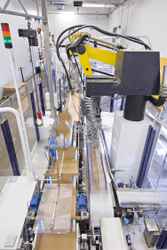
Posted to News on 11th Jun 2014, 09:48
Safety networks: The route from zero accidents to zero risk
As global competition continues to increase, how can you meet ever more stringent safety standards and still optimise productivity? As John Browett of CLPA explains, modern safety networks can hold the key.

On the plant floor, the demand for seamless communication and unobtrusive network layers has been an ongoing theme as companies look to push their productivity to world-class levels. More recently, that has been combined with a need for safety communication, where the network must still promote productivity but also assure safety and not be affected by other standard communications.
Meeting today's safety requirements on the plant floor means conforming to stringent international standards such as EN 13849-1 or EN 62061, according to the functional requirement and complexity of the system. This has fundamentally changed the approach to safety systems design, driving a safety ethos away from human intervention based on "zero accidents' to risk assessment based on "zero risk'.
The previous hard-wired approach to safety is giving way to a networked approach, built around safety controllers and safety PLCs, dedicated safety I/O, and the new generations of safety networks.
Combined with a safety PLC and safety I/O, these networks enable the implementation of distributed safety control for all systems, integrating seamlessly with standard control aspects of the application. The result is assured safety, the same wiring cost savings enjoyed for many years in standard control network installations, and no compromise on productivity. Indeed, when safety is embraced as part of a holistic view of production, today's safety network installations can actually contribute to boosting productivity.
Due to the requirements of Safety Integrity Level (SIL) certification, safety networks differ from standard control networks in the way in which they handle communication failures such as an unexpected delay in communication or erroneous data that may cause malfunction of an emergency stop operation. This fail-safety function will bring machinery into a safe condition quickly if a communication failure is detected. A safety master station maintains error and failure histories of the safety remote stations, as well as logging programme updates and controlling access to the system.
Today there are a number of choices for safety networks. To address the combined requirements of safety, productivity and integration, the CC-Link Partner Association (CLPA) offers two safety network options: a fieldbus option CC-Link Safety, and CC-Link IE Field Safety, a fully safety-enabled industrial Ethernet network protocol.
CC-Link Safety
Where there is a need to implement safety at device level over a selected number of safety I/O points, CC-Link Safety is a SIL-3 certified fieldbus network for use in safety applications that require compliance with IEC 61508 and EN 13849-1. It also offers the benefit of cost effective systems by allowing standard non-safety CC-Link fieldbus devices to be used on the safety network where needed.
The safety function has been achieved by adding safety function extensions to the CC-Link fieldbus protocol that offer the necessary additional data transmission integrity functions to meet the SIL-3 requirements. This enables CC-Link Safety to provide comprehensive safety while ensuring the same 10Mbit high-speed communication and high-speed response for safety communication as standard CC-Link fieldbus communication.
A CC-Link Safety system consists of a CC-Link Safety master station, one or more CC-Link Safety slave stations and, if required, standard CC-Link slave stations (remote I/O stations or remote device stations). The safety communication design can detect every communication error or malfunction, and maintain error and failure information on the network centrally - the safety master station records error and failure histories of the safety remote stations, which enhances troubleshooting.
CC-Link IE Field
Addressing the move to implement Industrial Ethernet in today's applications, the CLPA has added safety communication functions to the CC-Link IE Field network; an industrial Ethernet network that offers gigabit performance. A key benefit of the safety protocol is being able to share the same cable as normal CC-Link IE communications, meaning large cost savings on installation.
While it is speculation, it seems likely that safety standards will only become more stringent in the future. While it will never be possible to completely eliminate risk from a system, the latest safety network options enable risk to be mitigated to the lowest possible levels based on what is considered acceptable for the application. They provide highly flexible safety systems that will meet a wide range of application requirements, independent of the level of risk. At the same time, with the ability to integrate seamlessly with standard control systems, users can benefit from high levels of security and the assurance of optimised productivity.
To learn more about modern safety networks, please go to www.clpa-europe.com.
Want the latest machine building news straight to your inbox? Become a MachineBuilding member for free today >>

















